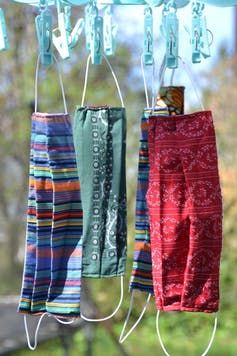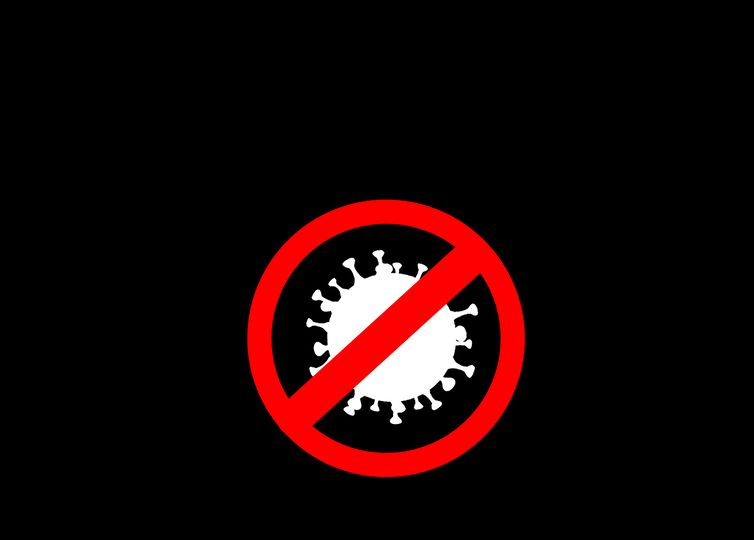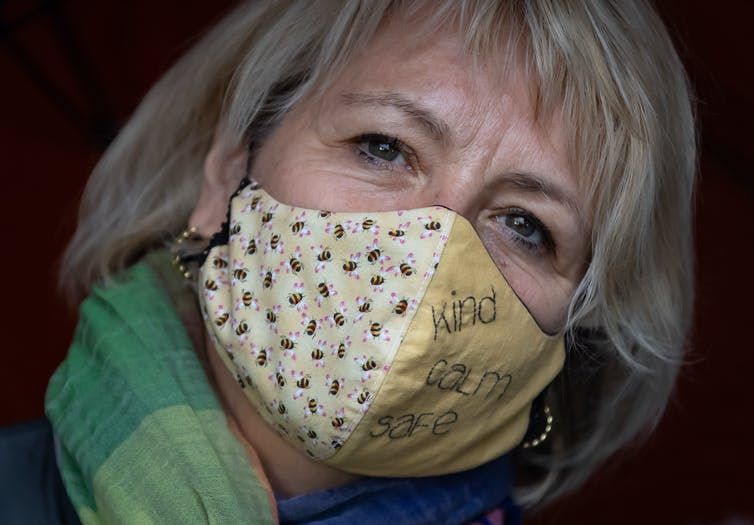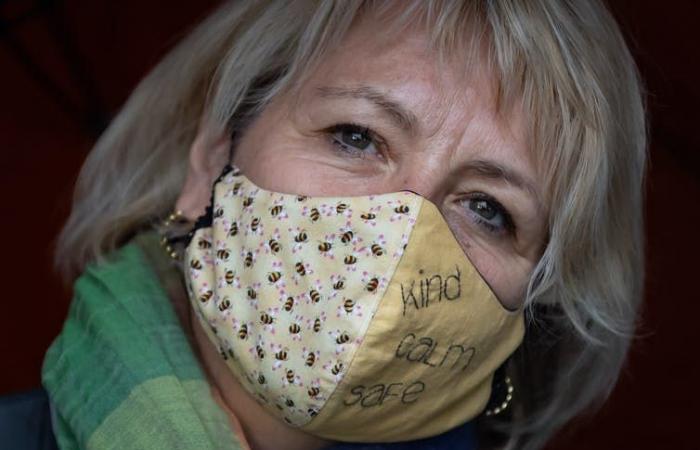Wearing a mask helps to minimize the spread of the virus transmitted through the respiratory tract. Although imperfect, their widespread use could make a big difference in the fight against the spread of the virus.
We began to study the publications on fabric masks at the onset of the pandemic, in an attempt to protect our vulnerable patients on dialysis and their caregivers. We identified 25 studies favorable to the wearing of the fabric mask, and summarized our findings in a peer-reviewed article. We have also created an evidence-based outreach website (clothmasks.ca) to familiarize the public with this topic.
Although the use of masks is widespread, many people still have questions.
I see through the fabric. How could it block particles?
The virus that causes Covid-19 is approximately one micron in diameter (one micron (µm) equals one thousandth of a millimeter). The space between the stitches of a fabric is visible to the naked eye, and measures approximately 5 to 200 microns. It is therefore paradoxical to think that it could be useful in this application – it has often been suggested that it would be as effective as using an openwork fence to stop mosquitoes. And yet this analogy is wrong in many ways.
Aerosol research shows that when a liquid remains in suspension, it makes it an aerosol, but other disciplines use the word “droplet” to define particles of five microns and larger, and reserve the term aerosol. to denote particles of five microns and less.
When we breathe, speak, eat, cough, sneeze or sing, we emit particles of many diameters, fine and large, and the virus they contain. Even though the threads of a fabric are spaced, they are generally wider than their spaces.
At the microscopic level, the thread is thick, which makes the gap between the stitches of the fabric more like a tunnel than a window. The microfilaments of broken or irregular threads fill the holes. The particles do not behave like an insect capable of redirecting its trajectory, but rather like a bullet hitting a wall, this is what we call impaction.
The Canadian Press / Ryan Remiorz
Two other processes come into play at the microscopic level. The particles “fall back” – this is called sedimentation. Some of these particles spin around at random, and their random movement brings them into contact with the fibers – this is called diffusion. Finally, a fabric can be made up of several thicknesses, which presents an additional obstacle to attack by the particles.
The question is therefore not whether certain particles pass through the tissues. But that some of them find themselves prohibited from access.
What are the most effective fabrics?
Based on the findings of 25 different studies, woven cotton (at a rate of at least 100 threads per inch); flannel, either 100% cotton or polycotton at a rate of at least 90 threads per inch); the fabric of the dish towels; and that of a thick, good-quality t-shirt: all these fabrics are valid. These recommendations are based on the available data, which, however, does not include all possible tissues; in fact, we have very little information on synthetic materials, and therefore cannot know if they are efficient.
All research on multi-layered fabrics confirms that layering fabrics improve protection, so we recommend that masks be made of at least two layers, even better, three or four. We have found proof of this both for masks made from the same materials and for those using different fabrics. However, we could not find any evidence for disposable filters such as coffee filters, so we cannot recommend their use.

(Pixabay)
For example, a two-layer t-shirt with a hem – to keep it from stretching – helped stop 79 percent of oral bacteria from dispersing during a coughing fit. The same experiment with a disposable surgical mask gave roughly comparable results, at 85 percent.
Two studies of surgical masks conducted in the 1960s and 1970s distinguished between thick particles (sometimes called droplets) and fine particles (sometimes called aerosols). A four-ply mask made from a cotton and flannel “sandwich” reduced both oral bacteria from particles of all sizes emitted during conversation by 99 percent and by 89 percent. fine particles.
It is therefore proven that cotton masks can block respiratory secretions before they reach the environment. Each particle, whatever its size, which remains captive in the mask will not remain suspended in the air, and will not fall back on surfaces which they could contaminate. “My mask protects you, and yours protects me”: If many people wear a mask, we expect the likelihood of transmitting the virus to decline.
Does a cloth mask protect the person wearing it?
We found four studies on indoor filtration, all four demonstrating an adequate level of filtration, and all based on widely validated technology that measures salt particles in a range of fine particles (0.02 to 0.05 microns). A study of masks made from one-ply dish towels, as well as masks made from a two-ply t-shirt, concluded that these two materials retained at least 50 percent of fine particles. Two cloth masks bought at random from street vendors performed the same. For comparison, two of these studies – using perfectly identical methods – analyzed the performance of disposable medical masks on volunteers: these masks filter about 80 percent of fine particles.
Three researchers at the University of Pittsburgh made complex custom-made masks from high-quality t-shirts, previously shrunk and made of 8 layers: each of these masks filtered out over 90 percent of fine particles, thus providing validation of the concept of making better quality fabric masks.

Pixabay
An animal experiment with the tuberculosis bacteria provides us with additional insight. Tuberculosis is generally classified as an airborne pathology, that is to say presenting a high rate of contamination due to its fine particles. When treating patients with TB, caregivers wear N95 masks, which provide a high level of protection, to protect themselves and others. The contamination rate of rabbits exposed to tuberculosis in a laboratory wearing a gauze mask of three to six layers was found to be 95 percent lower compared to animals without a mask.
Many cotton masks on the market therefore provide a satisfactory level of filtration, and we now have a validation of the concept of improved masks, both in terms of materials and their design.
At what rate of use does the mask become beneficial?
Two models tell us that a use rate of the order of 50 percent of masks effective at 50 percent would have a significant impact on transmission, and that if one of these two percentages were higher, the transmission would be even smaller. We need to work on improving masks, but those already available can already change the course of the pandemic, especially if most of us wear them.
The mandatory mask has been enforced on different dates in different states in the United States. Which makes it a natural experimentation ground. The daily rate of the spread of Covid-19 fell by one percent in the first five days and by two percent in the following 21 days when mask wear was imposed. This is a significant impact, as it represents 16 to 19 percent of the impact of more restrictive measures (closure of schools, ban on large group meetings, obligation to stay at home, closure of restaurants, bars and leisure establishments).
Taken as a whole, these observations suggest that commercially available masks reduce contamination, and that when made mandatory, the infection curve flattens. Seattle’s Institute for Health Metrics and Evaluation predicted on September 3 that moving from a mask use rate of 60 percent today to 95% percent, coupled with enhanced social distancing measures as needed would help achieve reduce the number of deaths worldwide to 750,000 by the end of 2020.
Are there other benefits of wearing the mask?

The Canadian Press / Darryl Dyck
A new hypothesis from researchers at the University of California at San Francisco indicates that not only do fabric masks reduce the likelihood of contagion, but also that reducing the amount of infectious organisms would decrease the severity of the disease.
The sum of the epidemiological evidence accumulated during the pandemic indicates that wearing a mask decreases the severity of the disease. The percentage of people infected but remaining asymptomatic is higher, and the likelihood of dying is reduced. In animal experiments, it is well known that the inoculated dose (inoculum) is directly related to the severity of the disease contracted. The threshold at which 50 percent of a group that receives the same dose is called the lethal dose 50 (LD50).
Experiments carried out on mice using the CoV – SMRO (Middle East Respiratory Syndrome Coronavirus) and SARS-CoV-1 (Severe Acute Respiratory Syndrome) coronaviruses, which caused the SARS epidemic in 2003, demonstrated the importance of dose response, and in the case of CoV-ORS determined the LD-50 concept. Hamsters protected by surgical masks suffered less severe infections than their unprotected counterparts.
Further research will allow further development of more effective masks. At the Center of Excellence for Protective Equipment and Materials at McMaster University, we plan to play a role in this area. But anyway, even imperfect use of even imperfect masks can have a major impact during this pandemic. Don’t let the best be the enemy of the good.
*We just want readers to access information more quickly and easily with other multilingual content, instead of information only available in a certain language.
*We always respect the copyright of the content of the author and always include the original link of the source article.If the author disagrees, just leave the report below the article, the article will be edited or deleted at the request of the author. Thanks very much! Best regards!
These were the details of the news All you need to know about anti-Covid-19 fabric masks, in five... for this day. We hope that we have succeeded by giving you the full details and information. To follow all our news, you can subscribe to the alerts system or to one of our different systems to provide you with all that is new.
It is also worth noting that the original news has been published and is available at en24news and the editorial team at AlKhaleej Today has confirmed it and it has been modified, and it may have been completely transferred or quoted from it and you can read and follow this news from its main source.




